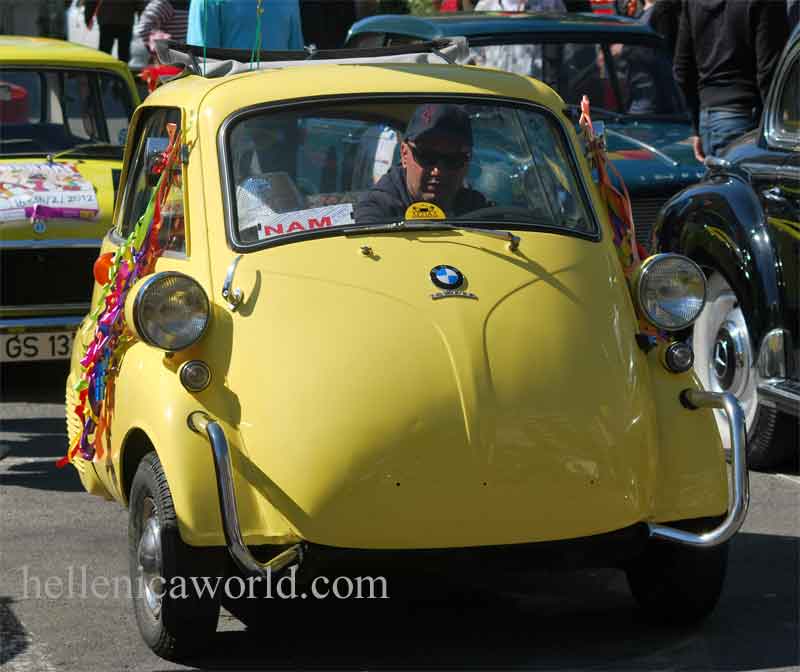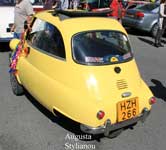.

BMW Isetta

1b,
BMW Isetta (Germany)
BMW made the Isetta its own. They redesigned the powerplant around a BMW one-cylinder, four-stroke, 247 cc motorcycle engine which generated 10 kW (13 hp). Although the major elements of the Italian design remained intact, BMW re-engineered much of the car, so much so that none of the parts between a BMW Isetta Moto Coupe and an Iso Isetta are interchangeable. The first BMW Isetta appeared in April 1955.
1955 BMW Isetta 250, BMW Museum, Munich, Germany.
In May 1962, three years after launching the conventionally modern-looking BMW 700, BMW ceased production of Isettas. A total of 161,728 units had been built.
BMW Isetta 250
While it retained the "Bubble Window" styling, it differed from the Italian model in that its headlamps were fixed separately to the sides of the bodywork and it carried the BMW badge below the windscreen. The car was also redesigned to take a modified version of the 250 cc four-stroke engine from the BMW R25/3 motorcycle and the front suspension was changed. The single-cylinder generated 9 kW (12 hp) at 5800 rpm. The crankcase and cylinder were made of cast iron, the cylinder head of aluminium. However, the head was rotated by 180° compared with the motorcycle engine. The twin-bearing crankshaft was also different in the Isetta power unit, being larger and featuring reinforced bearings. One of the reasons for this was the heavy Dynastart unit which combined the dynamo and self-starter. The fuel mixture was provided by a Bing sliding throttle side draft motorcycle carburetor. In addition to further changes of detail, the BMW engineers enlarged the sump for installation in the car and cooled the engine by means of a radial fan and shrouded ducting.
The power train from the four-speed gearbox to the two rear wheels was also unusual: fixed to the gearbox output drive was something called a Hardy disc, which was a cardan joint made of rubber. On the other side of it was a cardan shaft, and finally a second Hardy disc, which in turn was located at the entrance to a chain case. A duplex chain running in an oil bath led finally to a rigid shaft, at each end of which were the two rear wheels. Thanks to this elaborate power transfer, the engine-gearbox unit was both free of tension and well soundproofed in its linkage to the rear axle.
In Germany, the Isetta could even be driven with a motorcycle license. The top speed of the Isetta 250 was rated as 85 km/h (53 mph).
The first BMW Isetta rolled off the line in April 1955, and in the next eight months some 10,000 of the "bubblecars" were produced.
BMW Isetta 300
BMW 300 (Isetta) BMW 300 (Isetta)
Manufacturer BMW
Also called BMW Isetta
Production 1956-62
161,360 produced[15]
Predecessor BMW 250
Successor BMW 600
Layout RR layout
Engine 298 cc single-cylinder 4-stroke (53 mph (85 km/h) top speed)
Transmission 4-speed manual
In 1956, the government of the Federal Republic of Germany changed the regulations for motor vehicles. Class IV licences issued from that time onward could only be used to operate small motorcycles and could no longer be used to operate motor vehicles with a capacity of less than 250 cc. At the same time, the maximum capacity allowed for the Isetta's tax category was 300 cc. Class IV licences issued before the change in the regulations were grandfathered and allowed to be used as before.[citation needed]
BMW Isetta 300 interior
BMW Isetta 300 - Sliding Window 4-wheel LHD version
This change in regulations encouraged BMW to revise their Isetta microcars. In October 1956, the Isetta Moto Coupe DeLuxe (sliding-window Isetta) was introduced. The bubble windows were replaced by longer, sliding side windows. The engineers had enlarged the single cylinder to a 72 mm (2.8 in) bore and 73 mm (2.9 in) stroke, which gave a displacement of exactly 298 cc; at the same time, they raised the compression ratio from 6.8 to 7.0:1. As a result, the engine power output rose to 10 kW (13 hp) at 5200 rpm, and the torque rose to 18.4 N·m (13.6 ft·lbf) at 4600 rpm. The maximum speed remained at 85 km/h (53 mph), yet there was a marked increase in flexibility, chiefly noticeable on gradients.
BMW 600
Main article: BMW 600
BMW Isetta 600: the largest of the BMW Bubble Cars
The BMW 600 was intended as an enlarged Isetta with more power and a more conventional four-wheel configuration.
BMW Isetta 600, showing hinged steering wheel, next to 5'3" (160cm) boy
The front end of the 600 was virtually unchanged from the Isetta, but the 600's wheelbase was stretched to accommodate four seats. A conventional rear axle was added. BMW introduced the semi-trailing arm independent suspension on the 600. This suspension would be used on almost every new model for the next four decades. Because of the increased size and weight, the 600 had a more powerful engine than the Isetta. The 600 had the 582 cc twin engine from the R67 motorcycle. Top speed was 103 km/h (64 mph).
In two years, only 34,000 600s were produced, partly due to price competition with the entry-level VW Beetle. In the late 1950s, consumers wanted cars that looked like cars, and they had lost interest in economy models. Sales of the 600 were, however, aided by the energy crisis of 1956–1957.
BMW Isetta (United Kingdom)
British-registered LHD 3-wheeled Isetta
With space for two and their luggage, the Isetta was perfect for the UK's urban and rural roads. The first motorway, the M1, did not open until 1959, and more conventional cars such as early models of the Morris Minor could barely top 97 km/h (60 mph).
At one point, the British National Health Service started providing these vehicles for wheelchair users so they could drive while in their wheelchairs. Although noble in intent and many of these cars were made available free, the project was not deemed successful and was terminated.
In 1957, Isetta of Great Britain began producing Isetta 300 models at their factory in the former Brighton railway works under licence from BMW. The factory had no access by road, with components being delivered by rail, and finished cars being shipped out the same way.[16]
The British cars had right-hand drive with the door hinged from the right hand side of the car and the steering column moved across to the right as well. Right-hand drive meant that the driver AND the engine were on the same side, so a 27 kg (60 lb) counterweight was added to the left side to compensate. Dunlop tyres were used, and Lucas electrics replaced the German Hella and Bosch components, with a different headlamp housing being used. Girling brake components replaced the ATE brake parts.
The Isetta was not popular in the UK until a three-wheeled version was introduced, and although three-wheelers were more prone to rolling-over, there was a financial advantage: if the reverse gear was not installed, they could evade automobile legislation and taxation by being classed as three-wheeled motorcycles, and could be driven with a motorcycle licence. Isetta of Great Britain continued to produce four-wheeled Isettas, but only for export to Canada, New Zealand, and Australia.
In 1962, Isetta of Great Britain also stopped production of the little cars but continued to produce Isetta engines until 1964.
Isetta replica kits
The now defunct British firm Tri-Tech, under the model name "Zetta", sold a kit car or even an assembled complete BMW Isetta lookalike replica from modern parts, including Honda CN 250 cc single-cylinder water-cooled engines with automatic transmission (standard) or Kawasaki 500 GPS two-cylinder water-cooled motorcycle engines with optional manual transmission.
Some parts, new or used, were from "donor" vehicles. Front suspension and steering were from (General Motors) Bedford (later sold under the Vauxhall name) "Rascal" or the original and almost identical Suzuki "Supercarry" light duty van or pick-up trucks. Drum brakes and wheels were from Morris and the subsequent British Leyland Motor Corporation "Mini". Prices ranged from c. £2650 for the kit up to c. £9450 for a complete version.
It could be legally registered for use under British laws. Tri-Tech also supplied some body parts which can be used for running non-exact restorations of BMW Isettas.
BMW Isetta Hommage
A new version [17] of the BMW Isetta has been rumoured since 2007. Currently (November 2011), this is thought to be the concept vehicle for the BMW Mega City Vehicle project.[18][19]
From Wikipedia, All text is available under the terms of the GNU Free Documentation License
| Ancient Greece
Science, Technology , Medicine , Warfare, , Biographies , Life , Cities/Places/Maps , Arts , Literature , Philosophy ,Olympics, Mythology , History , Images Medieval Greece / Byzantine Empire Science, Technology, Arts, , Warfare , Literature, Biographies, Icons, History Modern Greece Cities, Islands, Regions, Fauna/Flora ,Biographies , History , Warfare, Science/Technology, Literature, Music , Arts , Film/Actors , Sport , Fashion --- |

